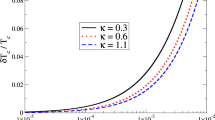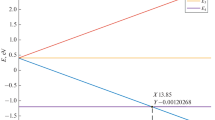Abstract
The critical behaviour of the electromagnetically coupled superconductor magnet system is investigated by means of a generalized mean field theory and a renormalization group analysis.
We show that in the presence of a genuine anisotropy in systems with an additional pressure-like parameter (like concentration in pseudo-ternary ferromagnetic superconductors (FMS), e.g. Er1−x Ho x Rh4B4) the indirect coupling between superconducting and magnetic order parameters (i.e. gauge coupling) can lead to a peculiar kind of critical behaviour characterized by Lifshitz points (LP). These points (quite generally) occur as merging points of three phases: a (magnetically) disordered phase, a homogeneously ordered phase and a modulated phase. In FMS the latter phase may result from exchange screening by supercurrents.
This unusual critical behaviour is found in two varieties:
-
1.
a regular LP which may occur on the lower transition line of a reentrant FMS
-
2.
a similar but slightly different critical point which we term modified Lifshitz point (MLP), and which is to be expected at the merging point of the upper and lower superconducting transition lines with the magnetic order disorder transition lines in the (x, T) phase diagrams of FMS's.
Similar content being viewed by others
References
A recent experimental review: Maple, M.B.: In: Proceedings of the Indo-U.S. Conference on the Science and Technology of the Rare Earths, held March 3–8, 1980, Cochin, Kerala, India
A recent theoretical review: Fulde, P., Keller, J.: In: Springer Series: Topics in current physics, superconductivity in ternary compounds. Fischer, O., Maple, M.B. (eds.), Vol. B, Chap. 8. Berlin, Heidelberg, New York: Springer Verlag
Krey, U.: Int. J. Magnetism3, 65 (1972);4, 153 (1973)
Blount, E.I., Varma, C.M.: Phys. Rev. Lett.42, 1079 (1979)
Kuper, C.G., Revzen, M., Ron, A.: Phys. Rev. Lett.44, 154 (1980)
Matsumoto, H., Umezawa, H., Tachiki, M.: Solid State Commun.31, 157 (1979)
Greenside, H.S., Blount, E.I., Varma, C.M.: Phys. Rev. Lett.46, 49 (1981)
Moncton, D.E., McWhan, D.B., Schmidt, P.H., Shirane, G., Thomlinson, W., Maple, M.B., MacKay, H.B., Woolf, L.D., Fisk, Z., Johnston, D.C.: Phys. Rev. Lett.45, 2060 (1980)
Grewe, N., Schuh, B.: Z. Phys. B—Condensed Matter36, 89 (1979)
Grewe, N., Schuh, B.: Phys. Rev. B22, 3183 (1980)
Grewe, N., Schuh, B.: Solid State Commun.37, 145 (1981)
Hornreich, R.M., Luban, M., Shtrikman, S.: Phys. Rev. Lett.35, 1678 (1975)
Selke, W.: Z. Phys. B—Condensed Matter29, 133 (1978)
Hornreich, R.M.: J. Mag. Magn. Mater.15–18, 387 (1980)
In order to distinguish between the fieldB which may be a fluctuating variable in the functional (1) and the equilibrium field satisfying the Ginzburg-Landau equations, the latter and its vector potential carry a subscript 0.B 0 is used here to expressM s through σ in a mean field context
This line of reasoning apparently excludes formation of vortices or domains and can only be applied to describe transitions to states with slight modulations inψ 0, such as the spiral or the linearly polarized coexistent states
Kleinert, H.: Phys. Lett.83A, 294 (1981)
Michelson, A.: Phys. Rev. B16, 577; 585 (1977)
Lynn, J.W., Shirane, G., Thomlinson, W., Shelton, R.N.: Phys. Rev. Lett.46, 368 (1981)
Michelson, A.: Phys. Rev. B16, 5121 (1977)
In the following we drop the fluctuations in the longitudinal partA ‖ of the vector potential. They are connected with local fluctuations of the charge density ρ since\(\dot \rho \sim - \nabla \cdot j_s \sim \nabla \cdot {\rm A}\) in the gauge used (and for constantψ 0). These fluctuations are controlled by an electric field term in the free energy which we have not included explicitely
Halperin, B.I., Lubensky, T.C., Shang-keng Ma: Phys. Rev. Lett.32, 292 (1974). See also Refs. 9a and 22
Wilson, K.G., Kogut, J.: Phys. Rev.12C, 75 (1974)
Jing-Huei Chen, Lubensky, T.C., Nelson, D.R.: Phys. Rev. B17, 4274 (1978)
In the course of the first renormalization steps couplings of the typeα 3 B,α 2 B 2, ... are generated since the propagator for the field ψ isq-dependent. A possible route to these couplings is shown in Fig. 8a. At criticality they are of order ε and contribute also to the mass coefficientsr andg. This is whown in Figs. 8b and 8c
Hu, C.-R., Ham, T.E.: Physica B+C108, 1041 (1981)
Odoni, W., Keller, G., Ott, H.R., Hamaker, H.C., Johnston, P.C., Maple, M.B.: Physica B+C108, 1227 (1981)
Brazovskii, S.A.: Sov. Phys. JETP41, 85 (1975)
Amit, D.J.: J. Phys. C7, 3369 (1974)
We drop the longitudinal fluctuations at this point since these are largely suppressed by electrostatic forces which are not contained in our description explicitely; see also [19]
Unless the upper critical dimensionality were given byd c=4+m, which is not the case as shown later
Due to gauge invariance the relation for the three vertexV jA leads to the same result
We refer to (76) as “standard” choice because form→0 it yields the standard rescaling\(\zeta _\psi ^2 = \lambda _b^{d + 2 - \eta _{ \psi } } \)
Comparing the two termsaψ2 andγ ψe2ψ2 A 2 in the free energy functional the Ginzburg criterion states that\(\langle \overline {A^2 } \rangle \sim \smallint d^d q\chi _A (q)\) must be of order a for mean field theory to be valid. Sinceμ ∼ ψ 20 aand\(\langle \overline {A^2 } \rangle \sim \mu ^{m/4 - 1} \) ifγ b B =0 or\(\langle \overline {A^2 } \rangle \mu ^{d/4 - 1} \) ifγ b B =1 we get in both casesd c=m=8
Author information
Authors and Affiliations
Additional information
Part of this work was performed during a one year visit of N.G. at the Institute for Theoretical Physics, Santa Barbara and a two year stay of B.S. at the Department of Physics at UCSD, La Jolla. Both authors gratefully acknowledge financial support by the Deutsche Forschungsgemeinschaft and the National Science Foundation (U.S.A.), grant PHY77-27084, as well as the hospitality of the departments at Santa Barbara and La Jolla
Rights and permissions
About this article
Cite this article
Schuh, B., Grewe, N. Lifshitz-point behaviour of ferromagnetic superconductors. Z. Physik B - Condensed Matter 46, 149–167 (1982). https://doi.org/10.1007/BF01312720
Received:
Issue Date:
DOI: https://doi.org/10.1007/BF01312720




